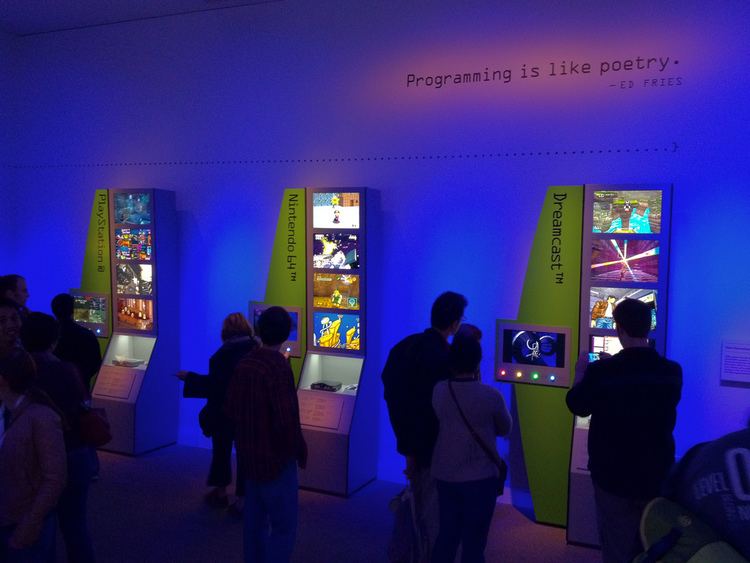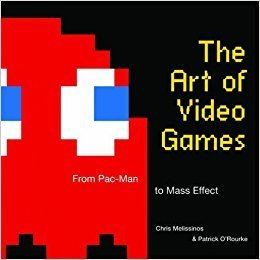 | ||
The art of video games chris melissinos curator
The Art of Video Games is an exhibition by the Smithsonian American Art Museum which was on display from March 16, 2012 through September 30, 2012. The exhibition was designed to highlight the evolution of art within the video game medium over its forty-year history. Following its time at the Smithsonian American Art Museum, the exhibition toured to 10 additional venues in the United States. Chris Melissinos, founder of Past Pixels and collector of video games and gaming systems, was the curator of the exhibition.
Contents
- The art of video games chris melissinos curator
- The art of video games exhibition trailer
- Purpose
- Public vote
- Galleries
- Games exhibited
- Era 4 Transition 19952002
- Subsequent exhibitions
- Book
- Reception
- References

The art of video games exhibition trailer
Purpose

The Art of Video Games was one of the first exhibitions to explore the forty-year evolution of video games as an artistic medium, with a focus on striking visual effects and the creative use of new technologies. It featured some of the most influential artists and designers during five eras of game technology, from early pioneers to contemporary designers (see grid below). The exhibition focused on the interplay of graphics, technology and storytelling through some of the best games for twenty gaming systems ranging from the Atari VCS to the PlayStation 3.
Public vote
The Smithsonian American Art Museum invited the public to help select the video games to be included in the exhibition. The 240 games on the ballot were selected by Chris Melissinos, who worked with the museum and an advisory group consisting of game developers, designers, industry pioneers, and journalists. The games were selected based on a variety of criteria, including visual effects, creative use of new technologies, and how the game fit into the narrative of the exhibition. Voting took place between February 14 and April 17, 2011. More than 3.7 million votes were cast by 119,000 people in 175 countries.
Galleries
Visitors to The Art of Video Games at the Smithsonian American Art Museum were greeted by a 12-foot projection that included excerpts from most of the 80 games featured in the exhibition with a chipmusic soundtrack written and recorded by 8 Bit Weapon and ComputeHer. An interior gallery included a series of short videos showing the range of emotional responses players of all ages have while interacting with games. Five themed videos addressing the themes of Beginnings, Inspiration, Narrative, Experience and The Future showcased excerpts from interviews with 20 influential figures in the gaming world—Nolan Bushnell, David Cage, Steve Cartwright, Jenova Chen, Don Daglow, Noah Falstein, Ed Fries, Ron Gilbert, Robin Hunicke, Henry Jenkins, Jennifer MacLean, RJ Mical, Mike Mika, David Perry, Jane Pinckard, George L. Rose, Kellee Santiago, Tim Schafer, Jesse Schell, Warren Spector and Tommy Tallarico. The videos are also available on the museum’s website. A five-channel installation displaying advances in core mechanics illustrated how home video games have evolved dramatically since their introduction in the 1970s through elements like avatars, jumping, running, climbing, flying, cutscenes and landscapes The room also held a selection of concept art from several games of different eras. Five playable games, one from each era, showed how players interact with diverse virtual worlds, highlighting innovative techniques that set the standard for many subsequent games. The playable games were Pac-Man, Super Mario Brothers, The Secret of Monkey Island, Myst, and Flower (video game). Interactive kiosks in the final gallery covered five eras of game technology, from early pioneers to contemporary designers, and 20 gaming systems from Ataric VCS to PlayStation 3. Each kiosk featured a game from each of four genres—action, target, adventure and tactics—that visitors could select to listen to commentary, game dialogue and music.
Games exhibited
The following list of games are those that were selected by Melissinos and the advisory board for inclusion in the exhibition. The exhibition is divided into five chronological eras, showcasing platforms from within that era. For each platform, three games from each of four game genres were initially selected for inclusion, with one game determined by the public voting to be part of the final exhibition. In addition, playable versions of five games are available: Pac-Man, Super Mario Bros., The Secret of Monkey Island, Myst, and Flower.
Era 4: Transition (1995–2002)
Subsequent exhibitions
Following its time at the Smithsonian, the exhibit was also shown at ten other venues across the United States, between 2013 and 2016.
Book
A companion book, The Art of Video Games: From Pac-Man to Mass Effect, accompanies the exhibition. It is written by Chris Melissinos, with a foreword by Elizabeth Broun, director of the Smithsonian American Art Museum and an introduction by Mike Mika, head of development for Other Ocean Interactive and a prominent advocate for the preservation of video game history. It also includes more than 100 composite images of games created by Patrick O’Rourke. The book, published by Welcome Books in cooperation with the Smithsonian American Art Museum, is available online and at bookstores nationwide (hardcover, $40).
Reception
An estimated 680,000 visitors came to the Smithsonian exhibit during its six-month display period.
The following is a sample of media coverage of the exhibition:
